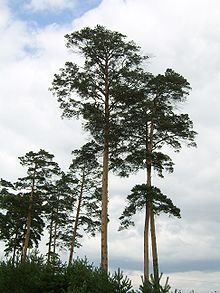Pinus densiflora
| Pinus densiflora | |
|---|---|

| |
| Scientific classification | |
| Kingdom: | Plantae |
| Clade: | Tracheophytes |
| Clade: | Gymnospermae |
| Division: | Pinophyta |
| Class: | Pinopsida |
| Order: | Pinales |
| Family: | Pinaceae |
| Genus: | Pinus |
| Subgenus: | P. subg. Pinus |
| Section: | P. sect. Pinus |
| Subsection: | P. subsect. Pinus |
| Species: | P. densiflora
|
| Binomial name | |
| Pinus densiflora | |
| Synonyms[2] | |
| |
Pinus densiflora, also called the Japanese red pine,[3] the Japanese pine,[4] or Korean red pine,[5] has a home range that includes Japan, the Korean Peninsula, northeastern China (Heilongjiang, Jilin, Liaoning, Shandong) and the extreme southeast of Russia (southern Primorsky Krai). This pine has become a popular ornamental and has several cultivars, but in the winter it becomes yellowish. The height of this tree is 20–35 m. The Korean red pine prefers full sun on well-drained, slightly acidic soil.
The leaves are needle-like, 8–12 cm long, with two per fascicle. The cones are 4–7 cm long. It is closely related to Scots pine, differing in the longer, slenderer leaves which are mid green without the glaucous-blue tone of Scots pine.
In Japan it is known as akamatsu (赤松, literally "red pine") and mematsu (雌松). It is widely cultivated in Japan both for timber production and as an ornamental tree, and plays an important part in the classic Japanese garden. Numerous cultivars have been selected, including the variegated semi-dwarf Oculus Draconis, the pendulous, often contorted Pendula and the multi-trunked 'Umbraculifera' (Japanese 多形松 tagyoushou, sometimes spelled as tanyosho).
In Korea, simply called sonamu (소나무, literally "pine tree"), it takes special status. Historically, Korean dynasties looked after it for timber and resin production banning laypeople from logging them. Korean aristocrats, or Yangban, loved it because they thought this evergreen tree represented virtues of Confucianism, "fidelity" and "fortitude". In this strongly confucian society, it became the national symbol. For the Korean people, even today, it is considered to represent Korean spirit and mentioned in the South Korean national anthem, Aegukga. Since it was introduced to the West by Japanese scholars, it was named the "Japanese red pine" in English. In Korea the KFS (Korea Forest Service) has changed the English name in Korea to 'Korean red pine'.[6]
References
- ^ Farjon, A. (2013). "Pinus densiflora". IUCN Red List of Threatened Species. 2013: e.T42355A2974820. doi:10.2305/IUCN.UK.2013-1.RLTS.T42355A2974820.en.
- ^ The Plant List: A Working List of All Plant Species, retrieved 15 December 2015
- ^ USDA, NRCS (n.d.). "Pinus densiflora". The PLANTS Database (plants.usda.gov). Greensboro, North Carolina: National Plant Data Team. Retrieved 31 January 2016.
- ^ "BSBI List 2007". Botanical Society of Britain and Ireland. Archived from the original (xls) on 23 October 2014. Retrieved 17 October 2015.
- ^ English Names for Korean Native Plants (PDF). Pocheon: Korea National Arboretum. 2015. p. 575. ISBN 978-89-97450-98-5. Archived from the original (PDF) on 25 May 2017. Retrieved 8 December 2016 – via Korea Forest Service.
- ^ "Korea's native plants to find new names". koreatimes. 2015-08-11. Retrieved 2016-05-07.
Further reading
- J. E., Aughanbaugh (1950). "Japanese Red Pine_cabdirect". Pennsylvania Forests and Waters. 2 (1): 10–11, 18.
-
Planted in a Japanese park
-
Planted in Japanese garden
-
Var. "Umbraculifera'
"Tanyosho pine" -
Planted in New York Botanical Garden
-
Pinus densiflora range map






